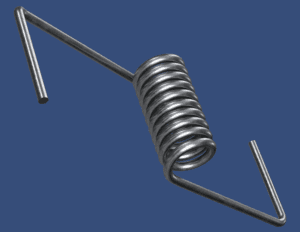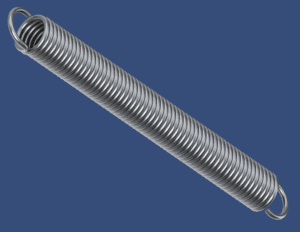If you have a garage door, have you ever thought about just how often you use it? It could be that you use your garage door once, twice, three times, or even more in just one day! Even though many people use this appliance every day, they do not realize there is a special tool that helps it open and close. These special tools, called garage door springs, are the main support for raising and lowering your garage door, so being aware of them is quite important. Imagine having to manually raise and lower your garage door each time you need to leave or get back home; it would be a hassle! That’s why it’s so important to know what garage door spring type you have as part of your automatic opening system. There are two different types of springs you could choose to have within your garage door. Learn about the different garage door spring types in our informative blog post!
Torsion Spring Type

What Is a Torsion Spring?
A torsion spring can be described as having helical springs that exert a torque or rotary force. This type of spring stores and releases rotational energy. The purpose of a torsion spring is to balance the garage door. Torsion springs ensure that the same amount of energy and force is applied to open and close a garage door. In addition, these springs generally last longer than other types of springs.
How a Torsion Spring Works
A torsion spring uses the ends of its spring to connect to a mechanical structure or part. When the spring engages in rotation, the process of the spring winding helps to create potential energy within the spring. Nevertheless, when the torsion spring is released, that stored energy also is released. To better understand how a torsion spring works, we should cover what “torque” means. Torque is a twisting force that aids in rotation. When this happens, the coils will twist and wind around the shaft. You can see this in action when you open your garage door.
Extension Spring Type

What Is an Extension Spring?
An extension spring can be described as having a helix-shaped wound spring so tightly compacted that it creates an initial tension within the coils. This initial tension can determine how tightly the coils are compacted, which also creates resistance toward a force when applied. An extension spring can be seen as having end coils, loops, or hoops which can be presented at the ends of the spring. The hoops and/or loops at the ends of the spring can be used to hook onto other objects that aid in the resistance of the spring.
How an Extensions Spring Works
Due to the resistance and force that this spring naturally possesses, it can absorb and store energy. In addition, this spring can resist a pulling force. Extension springs are hooked onto hardware within your garage door. Furthermore, when your garage door is open, your spring will be in its natural coiled state. However, when you close your garage door, your spring will be stretched.
What Is the Difference Between the Garage Door Spring Types?
While both the torsion and extension springs would work well in your garage, there are a few differences between these garage door spring types that are worth noting. Torsion springs are safer as they have fewer exposed parts to them. In addition, they tend to last longer and keep your garage door running smoothly. However, due to the longevity of the torsion springs, initial costs are higher. Extension springs can be commonly found within residential garage doors as they are a little more budget-friendly. Yet while extension springs are less expensive, they are also not as durable. This means that this spring may not last as long in comparison to the torsion spring.
Choose Your Garage Door Spring Type With Our Team’s Help!
ASAP Garage Door is a premier service provider that offers comprehensive solutions for your garage door. So, no matter what garage door spring type you choose, you can expect our experts to take care of your garage door needs! Call us at (210) 791-9216 or contact us on our site.



